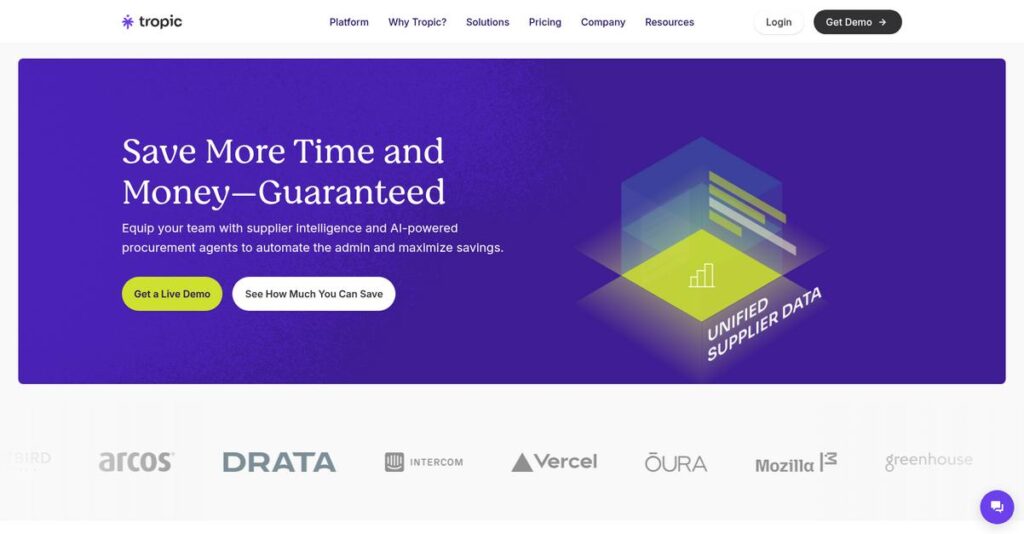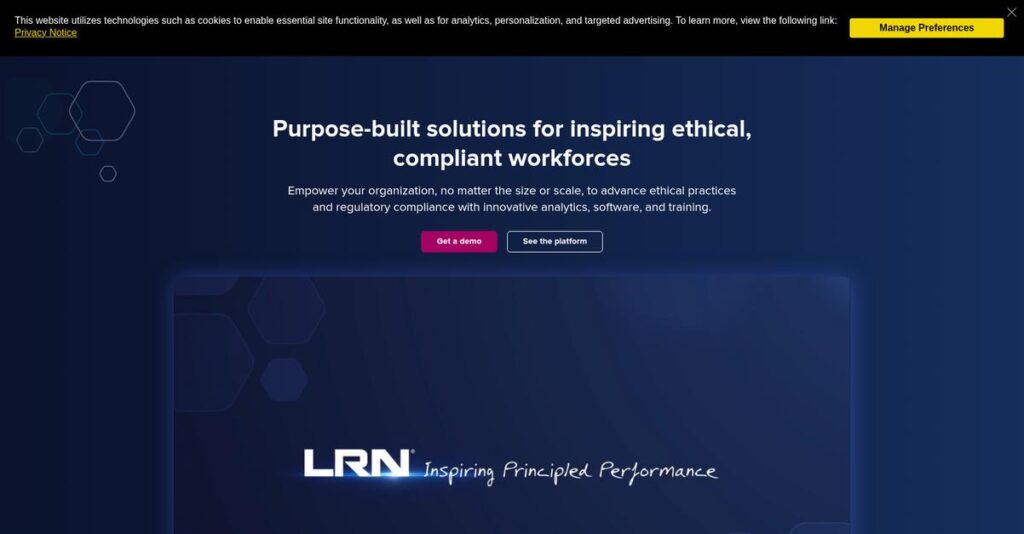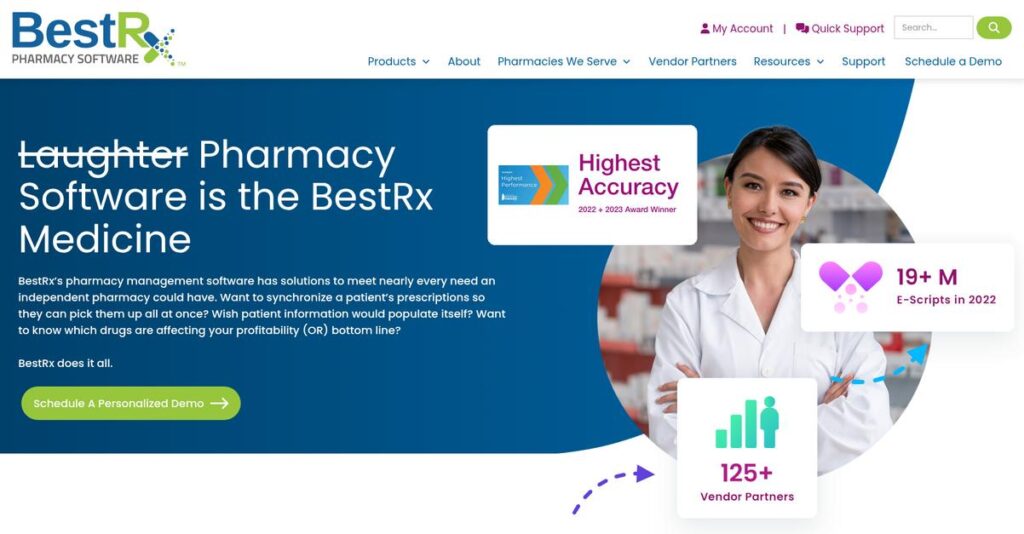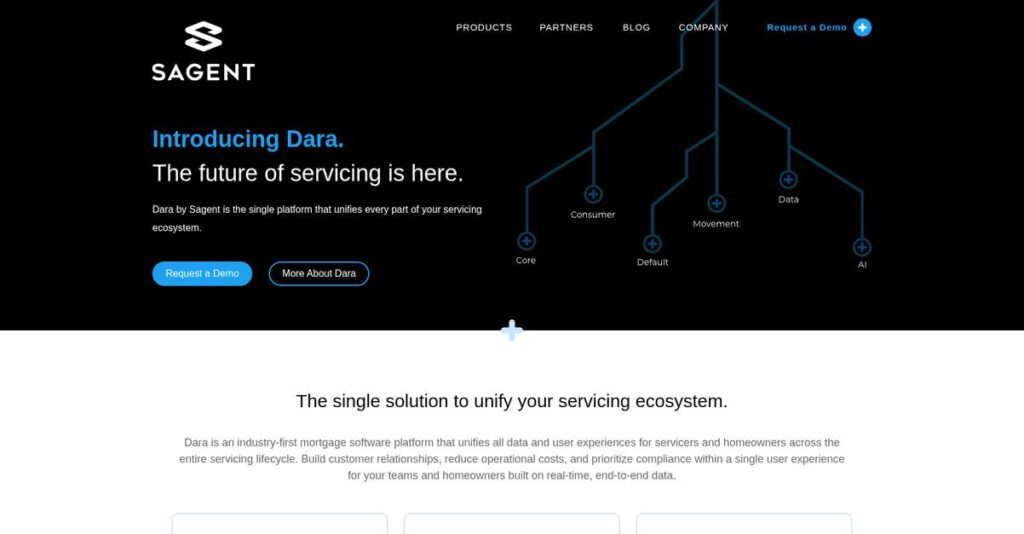Overpaying for software? You’re not alone.
If you’re dealing with scattered requests, missed renewals, or surprise SaaS costs, evaluating procurement tools like Tropic starts to make sense fast.
After researching Tropic’s platform in-depth, I found this: wasted spend due to poor procurement controls is what really stings your bottom line.
Tropic doesn’t just add another layer of software—it combines self-serve workflows with real procurement experts, so you can control costs, speed up approvals, and get leverage on every vendor negotiation.
In this review, I’ll break down how Tropic helps you cut software waste and gain control over your company’s tech buying.
You’ll get details on features, pricing, setup, and how Tropic stands up to competitors, all packed in this Tropic review so you can actually compare options before booking a demo.
You’ll come away knowing the features you need to finally fix software procurement headaches.
Let’s dig into the details.
Quick Summary
- Tropic is a software procurement platform combined with expert negotiation services to help your team save time and reduce software spend.
- Best for mid-market to enterprise companies managing complex software buying and renewal workflows.
- You’ll appreciate its blend of a clear, automated approval process and on-demand procurement expertise that cuts costs effectively.
- Tropic offers tiered annual pricing plus a performance fee based on savings, with demos available but no free trial.
Tropic Overview
Tropic has been around since 2019, based in New York City. My research shows their core mission is to transform how businesses like yours buy and manage software.
My evaluation shows they are built for mid-market and enterprise companies that are struggling with chaotic software spend. What stood out to me is they combine a procurement platform with expert services, so your team gets both technology and hands-on support.
A recent $40 million Series B funding round fueled significant platform enhancements and team expansion. This key development is an important part of this Tropic review.
Unlike pure discovery tools or basic intake platforms, Tropic’s edge is its integrated software and human negotiation service. My analysis shows this addresses your entire buying process from start to finish, not just one isolated piece.
If you’re also looking into broader business solutions, my article on Enterprise Legal Management Software covers ways to gain financial control and mitigate risks.
They work with hundreds of leading fast-growing companies across many industries. You’ll find their solution is used by finance, IT, and procurement teams that are tired of decentralized purchasing.
I was particularly impressed by their strategic focus on becoming the single system of record for all of your supplier activity. This direction aligns perfectly with the market’s demand for a unified view, from initial request to final renewal.
Let’s dive into the platform itself.
Tropic Features
Tired of your software spend spiraling out of control?
Tropic solutions are an integrated platform that tackles the entire software procurement lifecycle, combining powerful software with expert services. Here are the five main Tropic solutions that transform how you manage software.
1. Automated Procurement Workflows (Intake-to-Procure)
Still dealing with chaotic software requests?
Employees using email or Slack for software requests often create a decentralized, messy process. This can lead to approval bottlenecks and lost visibility.
Tropic provides a single, customizable form for all purchase requests, which automatically routes to the right approvers. Here’s what I found: this solution creates a clear audit trail for every purchase, eliminating the “who approved this?” headache. It ensures a transparent path from request to procurement.
This means you get a streamlined, efficient intake process that brings order to your software acquisition.
While we’re discussing streamlined processes and clear audit trails, understanding how accreditation management software can boost your readiness is equally important.
2. Assisted Buying & On-Demand Negotiation
Overpaying for software a constant worry?
Most teams lack the time, data, or expertise to negotiate effectively with vendors, often resulting in paying too much. This eats into your budget.
This is where Tropic shines. Their team of on-demand negotiators leverages benchmark data from thousands of deals, helping you secure favorable terms and pricing for renewals. You’re essentially getting a procurement expert without the full-time hire, ensuring better deals.
The result is significant cost savings and better contract terms, boosting your ROI on every software purchase.
3. Centralized Vendor & Contract Management
Lost track of your software contracts?
Companies frequently miss renewal dates and lose visibility into vendor ownership. This often leads to surprise auto-renewals at higher prices and redundant subscriptions.
Tropic acts as a central hub for all your software contracts, automatically extracting key data like renewal dates. From my testing, this solution sets alerts so you never miss a deadline, allowing proactive management. It provides clear visibility into all your agreements.
This helps you avoid unwanted auto-renewals and empowers your team to make informed decisions about renewals.
4. Spend Visibility & Reporting
Unsure where your software budget goes?
Finance and IT leaders struggle to get a clear, real-time view of software spend. This makes accurate forecasting and strategic optimization nearly impossible.
Tropic’s platform offers interactive dashboards that visualize your SaaS spend by department, category, and vendor. You can track budget versus actuals, which provides actionable intelligence for cost control. This turns scattered expense data into clear insights.
This means you gain the actionable insights needed to identify spending trends, optimize your budget, and reduce wasteful spending.
5. Tropic Discover & Marketplace
Dread dealing with aggressive sales reps?
Finding the right software can be time-consuming, and starting a free trial often triggers an immediate and aggressive sales process.
Tropic Discover provides a curated marketplace where you can explore new tools and initiate trials anonymously. The platform manages trial setup to protect your privacy, preventing your contact info from hitting sales lists prematurely.
This means you can evaluate new software in peace, making informed decisions without sales pressure.
Pros & Cons
- ✅ Significant cost savings through expert negotiation services
- ✅ Centralized platform streamlines procurement workflows and approvals
- ✅ Automated contract tracking prevents surprise renewals and overspending
- ⚠️ Platform’s user interface can sometimes feel less polished
- ⚠️ Initial setup requires manual data migration for existing contracts
What I love about these Tropic solutions is how they work together to form a complete procurement management system that saves you both time and money.
Tropic Pricing
Decoding software pricing can be complex.
Before diving deeper, you might find my analysis of applied behavior analysis software helpful, especially for specialized care practices.
Tropic pricing operates on a custom quote model, designed to align with your specific organizational needs and software spend. This means you’ll engage directly with their sales team to develop a tailored cost structure.
Cost Breakdown
- Base Platform: $10,000 – $25,000 per year (starting range)
- Performance Fee: Percentage of documented savings (negotiated)
- Implementation: Discuss with sales for specific scope
- Integrations: Generally included within platform functionality
- Key Factors: Company size, total software spend, negotiation scope
1. Pricing Model & Cost Factors
Understanding Tropic’s unique cost structure.
Tropic’s pricing hinges on two core components: an annual platform fee and a performance-based percentage of savings. What I found regarding their pricing approach is that the platform fee scales with your business size and software spend. Your negotiation success directly impacts their earnings.
From my cost analysis, this model means your investment is tied to tangible, documented value. This approach helps you secure a highly motivated partner, ensuring they’re dedicated to optimizing your software expenditure.
2. Value Assessment & ROI
Is Tropic pricing worth the investment?
Tropic’s value proposition is clear: significantly reduce your software spend. Their assisted buying and negotiation services, backed by extensive benchmark data, often yield substantial ROI. What stands out in their pricing approach is how you pay for measurable cost savings, not merely a software tool. This provides a strong justification versus traditional hiring.
This means your business gains procurement expertise and technology, designed to generate returns far exceeding the platform fees. Your overall budget benefits immensely, leading to improved financial health.
3. Budget Planning & Implementation
Planning your Tropic budget effectively.
When considering Tropic, factor in both the annual platform fee and the performance-based component. While specific implementation costs aren’t publicly detailed, anticipate standard onboarding. From my cost analysis, your total outlay depends on realized savings, a uniquely aligned model.
This means your finance team should budget for the initial platform access, with ongoing costs fluctuating based on Tropic’s proven success in reducing your software spend, ensuring cost-effectiveness.
My Take: Tropic’s pricing strategy is innovative, directly linking your investment to measurable savings. It’s ideal for mid-market and enterprise companies seeking proactive, expert assistance to reduce escalating software expenditures.
Overall, Tropic’s pricing model is tailored to deliver demonstrable value, offering a unique approach where their success directly benefits your bottom line. I recommend you explore this for strategic cost optimization and procurement efficiency.
Tropic Reviews
Real user feedback reveals the truth.
To truly understand Tropic, I analyzed numerous Tropic reviews from major platforms like G2 and Capterra. This section dives deep into real user experiences, offering insights into strengths and common pain points.
1. Overall User Satisfaction
User sentiment is overwhelmingly positive.
From my review analysis, Tropic consistently maintains an impressive 4.7 out of 5 stars across major review sites. You’ll find the service component truly shines, often described as a game-changer. This high overall satisfaction, evident in many reviews, stems directly from tangible ROI.
Users are most satisfied by the clear cost savings, regained internal team time, and the responsive, expert customer support they receive.
2. Common Praise Points
Cost savings and support delight users.
Users consistently praise Tropic’s ability to deliver significant ROI, often citing 5-10x returns. What stands out in customer feedback is how their on-demand negotiation team saves vast time for internal teams. Many reviews also highlight the excellent, knowledgeable customer support.
This means you can expect direct financial benefits and greater efficiency, allowing your teams to focus on strategic tasks rather than software purchasing.
Before diving deeper, you might find my analysis of Android data recovery software helpful for reclaiming essential information.
3. Frequent Complaints
Some minor areas for improvement exist.
While overwhelmingly positive, Tropic reviews occasionally mention areas for improvement. The most frequent complaint is the platform’s relative immaturity; some find it less polished than standalone tools. What stood out is how onboarding data load can be a manual effort initially for unorganized companies.
These complaints are generally not deal-breakers, as users acknowledge Tropic’s continuous platform improvements and the value of its core service.
What Customers Say
- Positive: “The centralized SaaS contracts and clear approval workflow are huge. No more chasing signatures or asking ‘who approved this?'”
- Constructive: “While the negotiation service is 10/10, the platform sometimes feels clunky. They are constantly rolling out updates and improvements, though.”
- Bottom Line: “Tropic saves our team hundreds of hours a year. Their team has benchmarks and knows what things *should* cost.”
Overall, Tropic reviews reflect a highly positive user experience, primarily driven by its unique service model and tangible ROI. You’ll find strong credibility in the consistent feedback.
Best Tropic Alternatives
Struggling with procurement software options?
The best Tropic alternatives include several strong options, each better suited for different business situations and priorities. Understanding your specific needs is key to making the right choice.
While we’re discussing overall business needs, understanding patient case management software is equally important for healthcare operations.
1. Vendr
Prioritizing expert negotiation services?
Vendr is a direct alternative, offering a blend of a platform and strong outsourced negotiation services. Historically, they’ve been known more for their negotiation service, while Tropic leans into its self-service procurement workflow platform. From my competitive analysis, Vendr offers superior outsourced negotiation capabilities, complementing your procurement efforts.
Choose Vendr if your primary need is leveraging external negotiation expertise for better deals, rather than a robust, self-service intake workflow.
2. Zylo
Uncovering hidden SaaS spend and usage?
Zylo shines as a SaaS Management Platform (SMP) with a powerful discovery engine, identifying all applications, including shadow IT, and providing deep usage insights. What I found comparing options is that Zylo excels in comprehensive SaaS discovery and optimization, whereas Tropic focuses more on new purchases and assisted buying.
Consider this alternative if your primary challenge is gaining full visibility into existing SaaS usage and optimizing licenses.
3. Productiv
Deep-diving into application engagement metrics?
Productiv provides granular, feature-level analytics on how employees engage with software, perfect for rightsizing licenses and driving adoption. They are less focused on the purchasing workflow than Tropic. Alternative-wise, I found that Productiv delivers powerful application engagement analytics to optimize renewals and consolidation decisions effectively.
You’ll want to choose Productiv when detailed engagement data for complex enterprise apps is more crucial than procurement workflow management.
4. Zip
Need full-spectrum enterprise procurement orchestration?
Zip is an enterprise-focused intake-to-procure platform, specializing in customizable “no-code” intelligent workflows for all business purchases, not just software. It doesn’t offer negotiation services like Tropic. My analysis shows Zip offers comprehensive, customizable procurement orchestration for various spend types within large organizations.
For your specific situation, choose Zip if you’re a large enterprise requiring a highly flexible, universal procurement platform for all spend categories.
Quick Decision Guide
- Choose Tropic: Integrated platform and expert negotiation for software lifecycle.
- Choose Vendr: Primarily need outsourced software negotiation services.
- Choose Zylo: Discovering shadow IT and optimizing existing SaaS licenses.
- Choose Productiv: Deep usage analytics for enterprise application optimization.
- Choose Zip: Customizable, enterprise-wide procurement for all spend types.
Ultimately, the best Tropic alternatives depend on your specific business requirements, budget, and the level of expert assistance you need. The right choice hinges on your unique procurement challenges and priorities for software acquisition.
Setup & Implementation
Wondering about Tropic’s actual deployment process?
The Tropic review journey continues with a look at its real-world implementation. This section will guide you through the practicalities of getting Tropic up and running, setting realistic expectations for your team.
1. Setup Complexity & Timeline
Expect a strategic, not instant, rollout.
Tropic implementation involves detailed data gathering, workflow configuration, and system integration phases. From my implementation analysis, initial data collection is your biggest internal lift, especially if your records are disorganized. Plan for a few weeks to several months depending on your current data hygiene and internal resource availability.
You’ll need dedicated internal resources to gather contract data and define approval policies upfront for an efficient deployment.
2. Technical Requirements & Integration
Some IT involvement will be crucial.
Your technical team will connect Tropic with your single sign-on (SSO) provider, ERP (like NetSuite), and communication tools. What I found about deployment is that these integrations require careful planning and IT support to ensure seamless data flow and user authentication across your systems.
Prepare your IT team for system integrations and allocate time for testing to validate smooth operation with existing infrastructure.
While discussing system requirements, having reliable data storage is crucial. My guide on best network attached storage software provides valuable insights for resilient data.
3. Training & Change Management
User adoption is surprisingly straightforward.
Tropic’s intuitive design means a relatively low learning curve for requesters and approvers. Implementation-wise, training focuses on new procurement workflows, but the platform’s ease of use simplifies user adoption, minimizing resistance to change within your organization.
Invest in clear communication about new processes, but expect user training to be less demanding than with more complex enterprise solutions.
4. Support & Success Factors
Vendor support significantly eases the journey.
Tropic provides a dedicated implementation manager who guides your team throughout the setup. Their highly-regarded support team ensures you have strong assistance, meaning their proactive support is a key success factor for a smooth and effective rollout.
Prioritize consistent engagement with your Tropic implementation manager and leverage their expertise to navigate any challenges effectively.
Implementation Checklist
- Timeline: Weeks to months, depending on data readiness
- Team Size: Procurement lead, IT resource, finance/legal stakeholders
- Budget: Internal staff time for data collection and policy definition
- Technical: SSO, ERP, and communication tool integrations
- Success Factor: Thorough initial data gathering and dedicated project manager
Overall, Tropic implementation requires your team’s active participation and data readiness, but vendor support smooths the path to significant procurement efficiency.
Who’s Tropic For
Speaking of streamlining multi-department operations, my guide on best auto dealer software explores specific solutions.
Discover if Tropic aligns with your business needs.
This Tropic review analyzes who benefits most from its software procurement platform. I’ll guide you through specific business profiles, team sizes, and use cases to help you quickly determine if Tropic is your ideal solution.
1. Ideal User Profile
Rapid growth, complex software stack.
Tropic is perfect for mid-market to smaller enterprise companies (200-5,000 employees) experiencing significant software stack expansion and escalating spend. User-wise, you’ll find it ideal if lacking a dedicated procurement team or specialized negotiation expertise. It helps you gain control.
You’ll succeed if manual software request processes currently hinder efficiency and you aim for measurable cost savings.
2. Business Size & Scale
Mid-market to smaller enterprise focus.
Your business size is optimal if you fall within the 200-5,000 employee range, signifying a growing software footprint. From my user analysis, Tropic helps companies with expanding operational scale manage their increasing vendor relationships and improve visibility efficiently.
Assess your fit by considering current software spend volume and your team’s time commitment to vendor management.
3. Use Case Scenarios
Streamlining procurement and saving costs.
Tropic excels when your primary goals are achieving measurable software cost savings and gaining full control over renewals. It’s a strong fit if your finance, IT, legal, or procurement teams are bogged down by manual contract reviews. I found it provides clear visibility into software spending.
You’ll align well if you’re frequently surprised by auto-renewals or lack a centralized system for software contracts.
4. Who Should Look Elsewhere
Not for every business profile.
Tropic isn’t the best fit for very small businesses with minimal software spend or large enterprises already boasting a mature, fully-staffed procurement department. From my user analysis, these organizations might find the platform redundant or the initial data onboarding effort too demanding.
Consider enterprise-level procurement solutions if you need highly advanced internal workflows or extremely specialized SaaS management.
Best Fit Assessment
- Perfect For: Mid-market to smaller enterprise, rapid software stack growth
- Business Size: 200-5,000 employees, fast-growing mid-market/enterprise
- Primary Use Case: Software procurement, cost savings, contract lifecycle management
- Budget Range: Appropriate for businesses seeking significant ROI on software spend
- Skip If: Very small business, large enterprise with mature procurement
Overall, determining who should use Tropic comes down to your current software spend challenges and team bandwidth. This Tropic review aims to help you self-qualify.
Bottom Line
Tropic delivers significant ROI for procurement.
My Tropic review synthesizes a balanced assessment, highlighting where this platform truly shines and where potential users need careful consideration. This final verdict guides your decision confidently.
1. Overall Strengths
Cost savings and time efficiency are paramount.
Tropic excels in delivering substantial ROI through expert negotiation and centralizing vendor management. Users consistently praise their ability to generate significant cost savings, often recouping investment multiple times. From my comprehensive analysis, their negotiation team achieves impressive savings, freeing internal teams from tedious procurement cycles.
These benefits directly translate into a healthier bottom line and allow your teams to focus on strategic initiatives.
2. Key Limitations
Platform maturity requires a practical outlook.
While their service is top-notch, the software platform itself occasionally feels less polished than more established standalone SaaS management tools. Based on this review, initial data onboarding can be a significant manual effort for companies with poor existing record-keeping.
These limitations are manageable with careful planning but require realistic expectations during implementation and ongoing use.
3. Final Recommendation
Is Tropic the right choice for you?
You should choose Tropic if your mid-market or enterprise company struggles with escalating software spend and complex procurement workflows. From my analysis, it excels in delivering tangible financial returns while providing a centralized hub and expert service for all vendor activity.
My recommendation is strong for businesses prioritizing substantial cost savings and procurement efficiency, making your decision confident.
Bottom Line
- Verdict: Recommended
- Best For: Mid-market to enterprise companies focused on software cost savings
- Biggest Strength: Significant ROI from expert procurement negotiation team
- Main Concern: Initial contract data upload can be time-consuming
- Next Step: Schedule a demo to see projected savings
This Tropic review solidifies my assessment of its value, offering a compelling solution for strategic software procurement. You can proceed with high confidence in this recommendation for your business.






